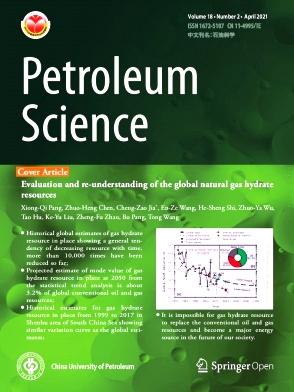利用马尔琴科自动聚焦理论消除复杂结构中的三维内部多重现象
IF 6
1区 工程技术
Q2 ENERGY & FUELS
引用次数: 0
摘要
本文章由计算机程序翻译,如有差异,请以英文原文为准。
Three-dimensional internal multiple elimination in complex structures using Marchenko autofocusing theory
Internal multiples are commonly present in seismic data due to variations in velocity or density of subsurface media. They can reduce the signal-to-noise ratio of seismic data and degrade the quality of the image. With the development of seismic exploration into deep and ultradeep events, especially those from complex targets in the western region of China, the internal multiple eliminations become increasingly challenging. Currently, three-dimensional (3D) seismic data are primarily used for oil and gas target recognition and drilling. Effectively eliminating internal multiples in 3D seismic data of complex structures and mitigating their adverse effects is crucial for enhancing the success rate of drilling. In this study, we propose an internal multiple prediction algorithm for 3D seismic data in complex structures using the Marchenko autofocusing theory. This method can predict the accurate internal multiples of time difference without an accurate velocity model and the implementation process mainly consists of several steps. Firstly, simulating direct waves with a 3D macroscopic velocity model. Secondly, using direct waves and 3D full seismic acquisition records to obtain the upgoing and downgoing Green's functions between the virtual source point and surface. Thirdly, constructing internal multiples of the relevant layers by upgoing and downgoing Green's functions. Finally, utilizing the adaptive matching subtraction method to remove predicted internal multiples from the original data to obtain seismic records without multiples. Compared with the two-dimensional (2D) Marchenko algorithm, the performance of the 3D Marchenko algorithm for internal multiple prediction has been significantly enhanced, resulting in higher computational accuracy. Numerical simulation test results indicate that our proposed method can effectively eliminate internal multiples in 3D seismic data, thereby exhibiting important theoretical and industrial application value.
求助全文
通过发布文献求助,成功后即可免费获取论文全文。
去求助
来源期刊

Petroleum Science
地学-地球化学与地球物理
CiteScore
7.70
自引率
16.10%
发文量
311
审稿时长
63 days
期刊介绍:
Petroleum Science is the only English journal in China on petroleum science and technology that is intended for professionals engaged in petroleum science research and technical applications all over the world, as well as the managerial personnel of oil companies. It covers petroleum geology, petroleum geophysics, petroleum engineering, petrochemistry & chemical engineering, petroleum mechanics, and economic management. It aims to introduce the latest results in oil industry research in China, promote cooperation in petroleum science research between China and the rest of the world, and build a bridge for scientific communication between China and the world.
 求助内容:
求助内容: 应助结果提醒方式:
应助结果提醒方式:


